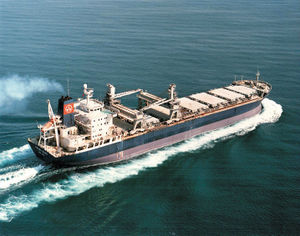Probo Baro
Contents
History
Oct 1988. Delivered as "Probo Baro" to Baoning Shipping/Baro Shipping, a 50/50 joint venture between John Swire and Sons and Torvald Klaveness.
2002. Renamed "Probo Panda".
2007. Renamed "Gulf Shagra"'
2011. Renamed "Hua Fu"
August 19th. 2011. Broken up at Chittagong, Beached Oct. 28th.2011.
Service
Bulkhandling Pool
Events / Stories
"The best laid plans, of mice and men, Dae gang full aft agley!"
The Probos represent a turning point in the history of merchant shipping as a whole, and one day they may make a very interesting business school case study.
In order to understand what motivated CNCo to go in for this venture, we need to first stand back a bit and recollect that, at least in the "theory" of merchant shipping as it was understood in the early 1980's, pools can make better use of ships than individual shipowners, pools of identical sister ships do better than pools of differing ships, "tight" pools with strict centralised management do better than "loose" pools, combination carriers spend less time in ballast than simple bulkers and tankers, the "conbulker" was still a valid concept, bulk carriers with box shaped holds were sought after for the forest products trades, and some shipowners, led by the Scandinavians, the Japanese and the Germans, believed that technology would allow them to operate ships whilst retaining national crews by employing far fewer men on each ship.
Given this set of assumptions, which were very widely shared in the industry at the time, a tight pool of ships able to carry oil products, liquid chemicals including caustic soda (SG 1.5), dry bulks, forest products and containers, all handled by the ship's gear, managed by very well regarded pool managers, with an expert marketing operation, should have been a good place to put your money.
The Bulkhandling pool was managed by Torvald Klaveness with A/S Havtor Management and Gill-Johannessen as Pool partners. The pool was initially offered the HUPEH (see entry for that ship) by CNCo but considered her unsuitable because of her centre line cranes. Torvald Klaveness proposed instead that CNCo join with them in two of the PROBO newbuildings, and CNCo accepted this proposal.
All should have gone as merrily as a marriage bell, except that the design of the ships was simply too ambitious.
Japanese yards refused to tender, on the grounds that the specification could not be met; there was a brief flirtation with a yard in Argentina (had this gone ahead, CNCo would have pulled out) and in the end an order for six ships was placed with Korea Shipbuilding and Engineering Ltd ("KSEC") by Klaveness and Havtor and their associates (Central Gulf Lines in the case of Havtor and CNCo in the case of Klaveness) and three ships were ordered from Hyundai Heavy Industries by Gill-Johannessen.
KSEC is now Hanjin Heavy Industries; this is because the PROBO litigation bankrupted the yard, which was sold to Hanjin by the liquidators.
As designed and as built the ships had very large Kvaerner pontoon hatch covers, handled by fittings on the elgs of the crane gantries and reinforced to resist the sloshing pressure of a caustic soda cargo at an SG of 1.5.
As designed and as built, the ships had a "barge shaped" hull form with a V section bow and a swim ended stern.
It was found that the hatches did not seal reliably; the ship "worked at sea more than the relatively rigid hatch covers.
In the case of the KSEC ships, the buyers also objected to the steering characteristics; if helm was applied at speed the ship pivoted round a point between No 1 and No 2 hatches, refused to answer counter helm and continued to turn until she had swung through more than 180 degrees and had lost steerage way.
Consequently the buyers rejected the ships.

